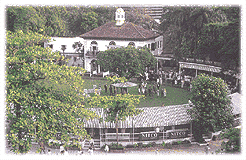The common
Mumbai-Pune betting totalisator was set in 1967 and all voice announcement heard at the
active centre are relayed to the ghost centre. Further progress was made in 1974, when a
pioneering effort inter-state inter-venue betting operations was made by accepting betting
in Bombay and Pune on the races held in Bangalore. The idea caught on rapidly and now
being used in other centres. The computers are connected by a Data Grade Circuit and an
exchange of summary information between Bombay and Pune is made on all bets placed. Thus,
the display of the latest approximate dividends on electronic display boards and the CCTV
network has been made possible.
The Club took the
pioneering step of introducing classic races for Indian breds in 1943. The Classics were
patterned after those in England. The 1000 and 2000 Guineas and the Derby were introduced
in 1943.
The Clubs celebrated its Diamond Jubilee as been registered under the Companies Act, 1976
by introducing the RWITC Ltd. Invitational Race which has since become a heady annual and
is now run in Pune.
Today there are about 1600 horses in training in Mumbai and they are sheltered in the
Clubs permanent stables at Mahalakshmi. Such a happy situation however does not obtain in
Pune where many horses have to be sheltered in temporary stables.
The Appelate body consists of six members duely elected and one member nominated by the
government. Any licencee aggrieved as a result of any action by the Stewerds can approach
the board for redressel by preferring an appeal. The increased number of veteranians in
the employ of the Club, the insistence that those aspiring to be trainers first work as
assistance with the established schoolers and to expand the activities of the Apprentice
Jockeys School which has been in existence for half a century.
As the enthusiasm for racing grows, as more owners, more
professionals and more horses come into racing, the demands on the club increase
proportionally. The RWITC is fully in tune with developments and keep pace, stride for
stride, with them. It has been a continous ongoing process and it will continue to be so.

